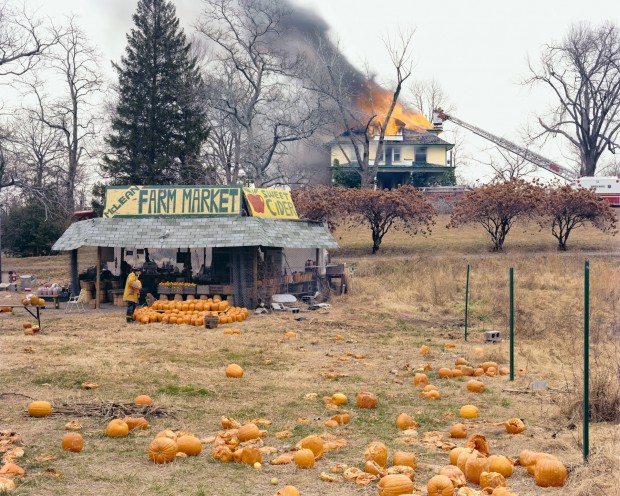An iconographic and text archive related to communication, technology and art.
☛ Luhring Augustine: “McLean, Virginia, December 1978”, from the series: American Prospects. The original image is a dye transfer print and measures 37.7 x 48.7 cm. (National Gallery of Canada). Luhring Augustine has a Digital c-print copies of 42″ x 52 1/2″ (image size). © Joel Sternfeld
This is probably Joel Sternfeld most famous image. It was first published in his book American Prospects (Times Books in association with The Museum of Fine Arts Houston, 1987) and also appeared in LIFE magazine (first in the Fall of 1988, then in the summer of 1991 for the collector issue The Best of Life Favorite Photographs 1978-1991).
At first it strongly reminded me of Jeff Wall’s “A Sudden Gust of Wind (after Hokusai)” (1993): both pictures somehow suggest autumn and involve various figures who appears to be strategically dispersed in a vast, but carefully controlled landscape (both images worth looking at in the largest format possible). The similarity, however, ends quickly upon further investigation. Jeff Wall’s photo was painstakingly staged in a number of planned sessions and then digitally manipulated before being exhibited as a very large (250 x 397 cm) transparent picture (cibachrome) encased in a light box. Joel Sternfeld’s photo was not staged at all: it could have been a snapshot if it hadn’t been taken by a professional photographer using eight-by-ten-inch camera. One thing was staged though (but not by Sternfeld): the fire was actually a training exercise for the McLean Volunteer Fire Department. One can read a first account of the story by one of the fireman who was on scene that day on Blake Andrews website: “American Prospects Revisited: McLean, VA 1978” (Oct. 31, 2009). Sternfeld’s photo is exhibited as a traditional dye transfer print of a average size (37.6 x 48.5 cm).
From The J. Paul Getty Museum:
Sternfeld earned a BA in Art from Dartmouth College in 1965. He began making color photographs in the 1970s after learning the color theory of Johannes Itten and Josef Albers. He initially made street photographs with small- and medium-format cameras, but by the time he produced what would become a seminal project, American Prospects (1987), he was working with an eight-by-ten-inch camera. This enabled him to achieve the crisp details his work is known for. Sternfeld’s style-his careful attention to visual qualities combined with an insightful and often ironic view of his subjects was first articulated in American Prospects. One of his best-known images, for example, depicts a fireman shopping for a pumpkin as a house burns in the background. The pumpkins’ vibrant oranges match the autumnal colors of the countryside, and ironically, the fire’s flames. (read more)
In his essay “Corrupting Photography” published in the revised edition of American Propspects in 2003 (Seidl), Kerry Brougher wrote:
Sternfeld aspired to “paint” a larger canvas or worldview that brought together figure, landscape, and narrative into one master frame that slowly reveals its secrets. His goal was to create a contemplative and slow viewing experience without returning to the late-nineteenth-century photographers’ mimicry of painting techniques with such “special effects” as diffused lighting and silhouetted imagery. He wanted to depict man’s place within the complex contemporary world, to reinvest the landscape with a sense of narrative, to offer vistas peppered with myriad details rendered in crystal clarity that, as much of traditional landscape painting, leave the viewer with a mystery yet to unravel. Bruegel, as well as other painters ranging from the Limbourg brothers to Jacob van Ruisdael used compositional and perspectival methods to bring the macrocosm into the microcosm, to examine man’s relationship to both tamed and untamed nature; their work offered Sternfeld a way of thinking about photography’s ability to create landscape imagery imbedded with meaning. (quote retrieved online from an essay by Damien Saatdjian “Notes on Malick, Misrach, Millet, Sternfeld”, July 24th, 2009)
To learn more about Joel Sternfeld’s book American Prospects one can visit Seidlville.com, the editor’s official website. Photo-Eye offers the possibility to browse through a couple pages of the book. Used copies of the book ―including sometimes of the first edition― can still be found online (see for example Abebooks).
Finally, here’s a collection of links pertaining to Joel Sternfeld photography, and more specifically about the American Prospects project:
-
His official website is… well, minimalist to say the least.
-
Luhring Augustine Gallery has 91 large format photographs by Joel Sternfeld, all properly identified.
-
The Albertina museum recently held a major exhibition about Joel Sternfeld’s work (27 June 2012 – 7 October 2012). Their website still offers 13 large format photos all properly labeled. If the link is broken, simply go to Albetina’s website and browse their “Past exhibition” section.
-
The Art Institute of Chicago has 202 photos by Joel Sternfeld. All are not available to see online, but one they are it’s in a small format reproduction with detailed information.
-
The MoMA has 61 photographs by Joel Sternfeld. Medium format reproductions are available to browse online alongside detailed attribution information. See for example “McLean, Virginia, December 1978”.
-
I’m not the only one to think of Jeff Wall when looking at Joel Sternfeld’s photographs. See for example “Joel Sternfeld” by Brian Dillon (Frieze, Issue 73, March 2003):
Some images propose a more straightforwardly readable scenography. McLean, Virginia, December 1978 is like something Jeff Wall would spend six months choreographing: a burning house with attendant fire engine; in the foreground, at the McLean Farm Market, a fireman nonchalantly buys a pumpkin (it turns out he’s the fire chief, wandering away from an exercise, not an emergency).
- By Philippe Theophanidis
- on
- ― Published in Art, Photography
- Tagged: autumn, fall, fire, Joel Sternfeld, landscape, snapshot

